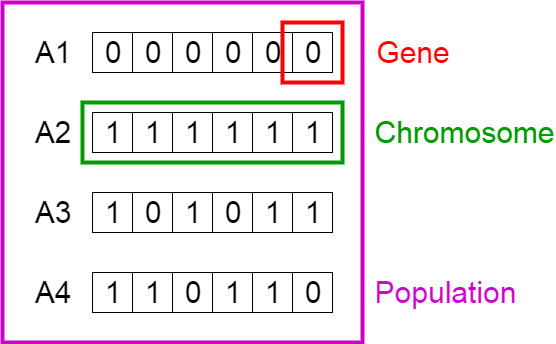A genetic algorithm is a search heuristic that is inspired by Charles Darwin’s theory of natural evolution. This algorithm reflects the process of natural selection where the fittest individuals are selected for reproduction in order to produce offspring of the next generation.
Notion of Natural Selection
The process of natural selection starts with the selection of fittest individuals from a population. They produce offspring which inherit the characteristics of the parents and will be added to the next generation. If parents have better fitness, their offspring will be better than parents and have a better chance at surviving. This process keeps on iterating and at the end, a generation with the fittest individuals will be found.
This notion can be applied for a search problem. We consider a set of solutions for a problem and select the set of best ones out of them.
Five phases are considered in a genetic algorithm.
- Initial population
- Fitness function
- Selection
- Crossover
- Mutation
Initial Population
The process begins with a set of individuals which is called a Population. Each individual is a solution to the problem you want to solve.
An individual is characterized by a set of parameters (variables) known as Genes. Genes are joined into a string to form a Chromosome (solution).
In a genetic algorithm, the set of genes of an individual is represented using a string, in terms of an alphabet. Usually, binary values are used (string of 1s and 0s).

Fitness Function
The fitness function determines how fit an individual is (the ability of an individual to compete with other individuals). It gives a fitness score to each individual. The probability that an individual will be selected for reproduction is based on its fitness score.
Selection
The idea of selection phase is to select the fittest individuals and let them pass their genes to the next generation.
Two pairs of individuals (parents) are selected based on their fitness scores. Individuals with high fitness have more chance to be selected for reproduction.
Crossover
Crossover is the most significant phase in a genetic algorithm. For each pair of parents to be mated, a crossover point is chosen at random from within the genes.
For example, consider the crossover point to be 3 as shown below.

Offspring are created by exchanging the genes of parents among themselves until the crossover point is reached.

The new offspring are added to the population.

Mutation
In certain new offspring formed, some of their genes can be subjected to a mutation with a low random probability. This implies that some of the bits in the bit string can be flipped.

Mutation occurs to maintain diversity within the population and prevent premature convergence.
Termination
The algorithm terminates if the population has converged (does not produce offspring which are significantly different from the previous generation). Then it is said that the genetic algorithm has provided a set of solutions to our problem.
Comments
The population has a fixed size. As new generations are formed, individuals with least fitness die, providing space for new offspring.
The sequence of phases is repeated to produce individuals in each new generation which are better than the previous generation.
Psuedocode
START
Generate the initial population
Compute fitness
REPEAT
Selection
Crossover
Mutation
Compute fitness
UNTIL population has converged
STOP
References
Introduction to Genetic Algorithms – https://www.youtube.com/watch?v=zwYV11a__HQ
Genetic Algorithm – explained in 4 minutes – https://www.youtube.com/watch?v=Y-XMh-iw07w
An Introduction to Genetic Algorithms by Melanie Mitchell – https://pdfs.semanticscholar.org/e0fd/bda2b7ebab03f798f9d33847050d012df9cc.pdf


Simple and short, yet comprehensive and complete. Keep up the good work 😊
LikeLiked by 1 person
Thank you very much 😀
LikeLiked by 1 person
Really helpful. 😀
LikeLiked by 1 person
Thank you very much… 🙂
LikeLike
The last link in the reference is not working, can you please switch the link. Rest the content is very good and the language used is quite self-explanatory
LikeLiked by 1 person
Thank you very much for the comments.
It has been 2 years since I wrote this article. I will try to fix the link. Thanks for letting me know.
LikeLike